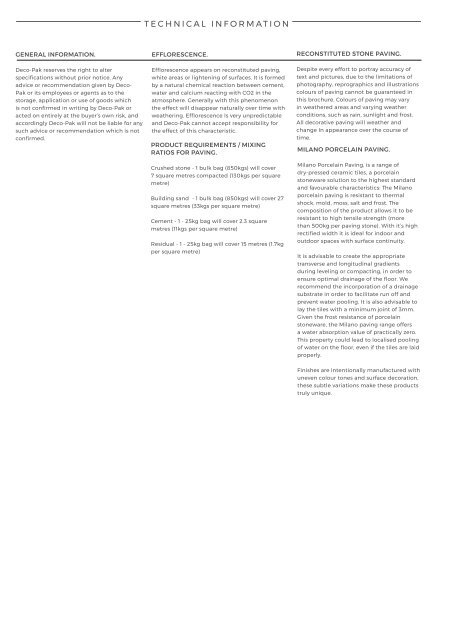You also want an ePaper? Increase the reach of your titles
YUMPU automatically turns print PDFs into web optimized ePapers that Google loves.
General INFORMATION.<br />
Deco-Pak reserves the right to alter<br />
specifications without prior notice. Any<br />
advice or recommendation given by Deco-<br />
Pak or its employees or agents as to the<br />
storage, application or use of goods which<br />
is not confirmed in writing by Deco-Pak or<br />
acted on entirely at the buyer’s own risk, and<br />
accordingly Deco-Pak will not be liable for any<br />
such advice or recommendation which is not<br />
confirmed.<br />
TECHNICAL INFORMATION<br />
Efflorescence.<br />
Efflorescence appears on reconstituted paving,<br />
white areas or lightening of surfaces. It is formed<br />
by a natural chemical reaction between cement,<br />
water and calcium reacting with CO2 in the<br />
atmosphere. Generally with this phenomenon<br />
the effect will disappear naturally over time with<br />
weathering. Efflorescence Is very unpredictable<br />
and Deco-Pak cannot accept responsibility for<br />
the effect of this characteristic.<br />
PRODUCT REQUIREMENTS / MIXING<br />
RATIOS FOR PAVING.<br />
Crushed stone - 1 bulk bag (850kgs) will cover<br />
7 square metres compacted (130kgs per square<br />
metre)<br />
Building sand - 1 bulk bag (850kgs) will cover 27<br />
square metres (33kgs per square metre)<br />
Cement - 1 - 25kg bag will cover 2.3 square<br />
metres (11kgs per square metre)<br />
Residual - 1 - 25kg bag will cover 15 metres (1.7kg<br />
per square metre)<br />
RECONSTITUTED STONE PAVING.<br />
Despite every effort to portray accuracy of<br />
text and pictures, due to the limitations of<br />
photography, reprographics and illustrations<br />
colours of paving cannot be guaranteed in<br />
this brochure. Colours of paving may vary<br />
in weathered areas and varying weather<br />
conditions, such as rain, sunlight and frost.<br />
All decorative paving will weather and<br />
change In appearance over the course of<br />
time.<br />
Milano PORCELAIN Paving.<br />
Milano Porcelain Paving, is a range of<br />
dry-pressed ceramic tiles, a porcelain<br />
stoneware solution to the highest standard<br />
and favourable characteristics: The Milano<br />
porcelain paving is resistant to thermal<br />
shock, mold, moss, salt and frost. The<br />
composition of the product allows it to be<br />
resistant to high tensile strength (more<br />
than 500kg per paving stone). With it’s high<br />
rectified width it is ideal for indoor and<br />
outdoor spaces with surface continuity.<br />
It is advisable to create the appropriate<br />
transverse and longitudinal gradients<br />
during leveling or compacting, in order to<br />
ensure optimal drainage of the floor. We<br />
recommend the incorporation of a drainage<br />
substrate in order to facilitate run off and<br />
prevent water pooling. It is also advisable to<br />
lay the tiles with a minimum joint of 3mm.<br />
Given the frost resistance of porcelain<br />
stoneware, the Milano paving range offers<br />
a water absorption value of practically zero.<br />
This property could lead to localised pooling<br />
of water on the floor, even if the tiles are laid<br />
properly.<br />
HEALTH AND Safety.<br />
Due to the heavy nature of our products we<br />
always recommend suitable lifting equipment<br />
to be used.<br />
Always wear appropriate protective wear e.g.<br />
gloves and safety footwear when handling the<br />
products.<br />
Always wear safety goggles and appropriate<br />
respiratory protection when using cutting<br />
equipment.<br />
Ensure the products are on level ground<br />
retained in some way before removing<br />
packaging.<br />
Always handle with care as breakages and<br />
chippings may result from mishandling.<br />
For larger products such as paving we<br />
recommend the use of lifting equipment such<br />
as a vacuum lift.<br />
Minor scuffing can occur due to movement in<br />
transit and will generally disappear in time.<br />
HOW TO LAY A PATH.<br />
Step 1: Choose a relatively flat, low traffic site for<br />
your walkway and dig out a path to a depth of<br />
2-4 inches (5-10cm).<br />
Step 2: Place large stones, single file, along both<br />
edges. The Deco-Pak range of boulders and<br />
rockery stones, available at the garden centre<br />
are ideal for this purpose.<br />
Step 3: You will need a permeable landscaping<br />
fabric to separate your gravel from the soil<br />
beneath - and to suppress weeds. Deco-Pak<br />
professional grade, heavy duty, Ground Control<br />
Fabric (RRP £7.99 for a 10 x 1m roll) is ideal - just<br />
ensure there is at least a few inches overlap each<br />
side of your path. Tuck the fabric under the<br />
stones and you’re ready for the final step.<br />
Step 4: Choose a decorative gravel to lay over the<br />
path. Some prefer a round pebble style covering<br />
as it is less likely to get compacted, others a<br />
more angular and crunchy surface.<br />
Check out how to lay paving and our gravel<br />
calculator on the Deco-Pak website:<br />
www.deco-pak.co.uk/gravel-calculator<br />
HOW TO INSTALL PAVING.<br />
Step 1: Excavate approx 150mm of the surface<br />
until the ground feels hard. Replace this with<br />
approximately 100mm of crushed stone and<br />
compact using a vibrating plate or roller. We<br />
recommend a gradient fall of round 1 in 60 for<br />
drainage.<br />
Step 2: Peg or mark the area which you intend<br />
to pave. It is an idea to work in a parallel line<br />
from say a building or existing path.<br />
Step 3: Using a cement mixer, mix 3 parts<br />
building sand to 1 part cement until the<br />
consistency is workable, not too wet. Place<br />
several spots where your first slab is to be laid,<br />
place your slab onto the mortar, and tap into<br />
place using a rubber mallet. Level the slab using<br />
a spirit level and use a line band to ensure that<br />
your slabs will follow a straight line.<br />
Step 4: Repeat step 3 ensuring that the<br />
joints between each slab are near equal. We<br />
recommend slabs about 5mm apart (at the<br />
bottom) to create the correct width joint. Make<br />
sure that no one can walk on your new patio<br />
area for ideally, 2 days<br />
Step 5: Mix 2 parts silver sand to 1 part cement<br />
until the consistency is workable but not too<br />
wet. Place a small amount of mortar onto a<br />
hand board and push the mortar into the joints<br />
with a pointing trowel. Be careful not to drop<br />
the mortar on top of the paving as this will most<br />
certainly stain the surface of the slab. Remove<br />
any spillages with clean water immediately.<br />
Finishes are intentionally manufactured with<br />
uneven colour tones and surface decoration,<br />
these subtle variations make these products<br />
truly unique.




